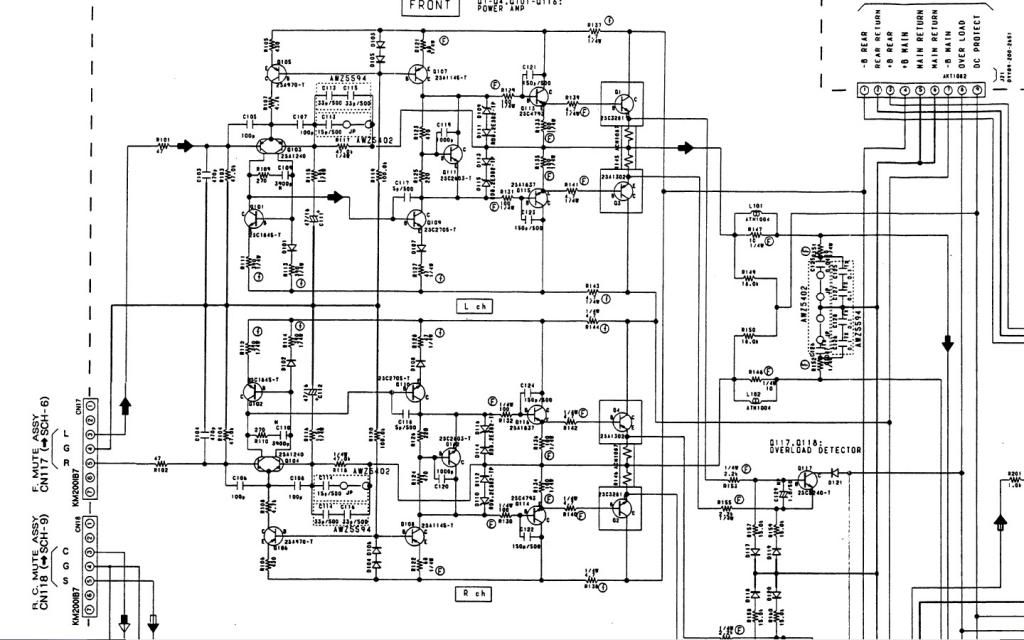Lately I have seen a lot of Pro-Logic recievers from early to late 90s, with dead display, failed surround channels etc.
Here is an example of a Pro-logic receiver I acquired with such issues.
Pioneer VSX-D633S Manual - Audio Video Stereo Receiver - HiFi Engine
A Pioneer VSX-633S
Specs on paper sounds interesting…
Power output: 130 watts per channel into 8Ω (stereo)
Surround output: 100W (front), 100W (center), 50W (rear)
Frequency response: 5Hz to 100kHz
Total harmonic distortion: 0.05%
I was just wondering whether it would be worthwhile to strip them only to 2 channel power amp stage, directly access the power-amp inputs and skip input selectors, volume controllers etc. May be add a line level gain stage for power-amp if needed. Re-cap the whole power amp section. Remove all the other un-necessary boards. Is it even possible? And most importantly is it worth doing this? Or would I endup wasting time as the Amp is going to sound mediocre anyway?
Here is an example of a Pro-logic receiver I acquired with such issues.
Pioneer VSX-D633S Manual - Audio Video Stereo Receiver - HiFi Engine
A Pioneer VSX-633S
Specs on paper sounds interesting…
Power output: 130 watts per channel into 8Ω (stereo)
Surround output: 100W (front), 100W (center), 50W (rear)
Frequency response: 5Hz to 100kHz
Total harmonic distortion: 0.05%
I was just wondering whether it would be worthwhile to strip them only to 2 channel power amp stage, directly access the power-amp inputs and skip input selectors, volume controllers etc. May be add a line level gain stage for power-amp if needed. Re-cap the whole power amp section. Remove all the other un-necessary boards. Is it even possible? And most importantly is it worth doing this? Or would I endup wasting time as the Amp is going to sound mediocre anyway?
Last edited:
I think you could do more than just a dumb power amp (though that would be feasible). Units like this still contain a 4-gang volume pot, which I would definitely be willing to use for a 2-stage volume control in a stereo hack. (2-stage volume control is something you only see in high-end preamps or modern-day PGAs.) Normally you see volume pot - 16 dB of preamp gain - 29 dB of power amp gain. I would want the signal to take a detour after the preamp, going to the two other volume pot gangs followed by a unity-gain buffer instead before heading to the power amp. This would give you much-reduced output noise level, becoming essentially inaudible even on sensitive speakers (stock noise spec, by contrast, is decidedly average).
The power amps should be quite OK. Nothing exciting from a measurements POV but generally still good enough that you wouldn't pick them out in a blind challenge.
Do verify what sort of opamps are being used and what the layout is like. I have a '97 Onkyo that is stuffed with SIP formfactor NJM4558s, for which very few better alternatives exist (I think Mouser has NJM4560s and NJM2068s, with the latter probably requiring some extra local decoupling).
The power amps should be quite OK. Nothing exciting from a measurements POV but generally still good enough that you wouldn't pick them out in a blind challenge.
Do verify what sort of opamps are being used and what the layout is like. I have a '97 Onkyo that is stuffed with SIP formfactor NJM4558s, for which very few better alternatives exist (I think Mouser has NJM4560s and NJM2068s, with the latter probably requiring some extra local decoupling).
if you come accross an old JVC receiver, those with SuperA circuitry, those are definitely worth to get and use as power amps...even if they are 5 channel, they most of the time have those 2 main channels as the most powerful and best sounding sporting the SuperA circuitry
it is extremely easy to hack them as power amp only, as they have connector leading to the power amp module board, you just cut this and lead it out to the connector...careful, as this is often very sensitive and I use trimmer or pot here to attenuate the signal
it is extremely easy to hack them as power amp only, as they have connector leading to the power amp module board, you just cut this and lead it out to the connector...careful, as this is often very sensitive and I use trimmer or pot here to attenuate the signal
Here is the schematic for the one I am gonna hack this weekend(most likely). It is a Pioneer VSX-D633S. Says its 130W per channel 🙂 in to 8ohms in Stereo mode..
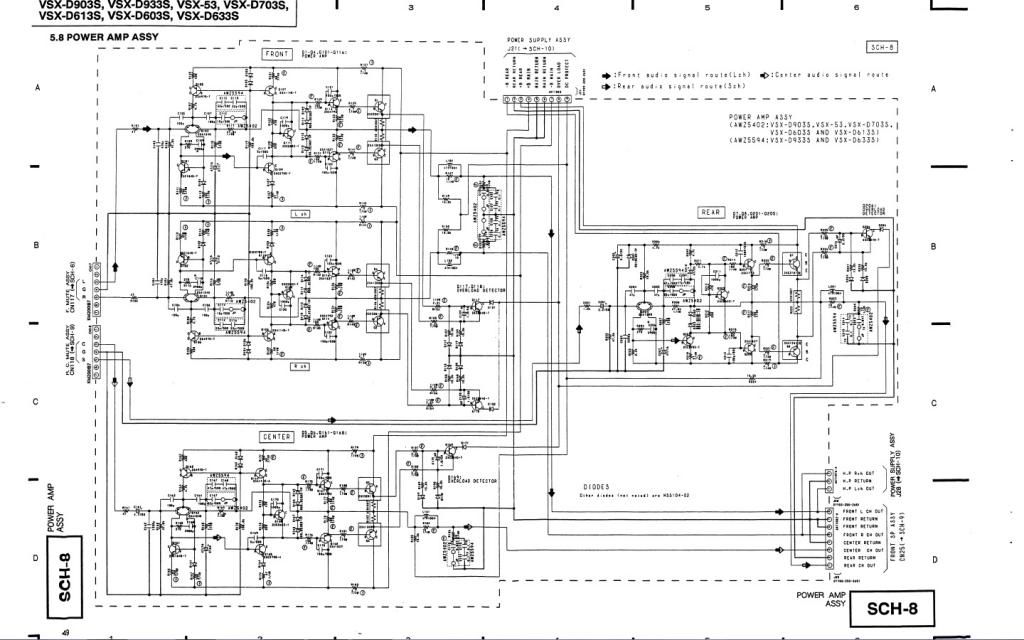
From the circuit it looks like 4 identical power stages? 2 for Front(Main) L and R, then one center and One channel split in to SL and SR? Since Dolby Prologic, Surround anyway is only one channel split in to two...

From the circuit it looks like 4 identical power stages? 2 for Front(Main) L and R, then one center and One channel split in to SL and SR? Since Dolby Prologic, Surround anyway is only one channel split in to two...
I think you could do more than just a dumb power amp (though that would be feasible). Units like this still contain a 4-gang volume pot, which I would definitely be willing to use for a 2-stage volume control in a stereo hack. (2-stage volume control is something you only see in high-end preamps or modern-day PGAs.) Normally you see volume pot - 16 dB of preamp gain - 29 dB of power amp gain. I would want the signal to take a detour after the preamp, going to the two other volume pot gangs followed by a unity-gain buffer instead before heading to the power amp. This would give you much-reduced output noise level, becoming essentially inaudible even on sensitive speakers (stock noise spec, by contrast, is decidedly average).
The power amps should be quite OK. Nothing exciting from a measurements POV but generally still good enough that you wouldn't pick them out in a blind challenge.
Do verify what sort of opamps are being used and what the layout is like. I have a '97 Onkyo that is stuffed with SIP formfactor NJM4558s, for which very few better alternatives exist (I think Mouser has NJM4560s and NJM2068s, with the latter probably requiring some extra local decoupling).
Thanks for that different perspective. I was not really thinking about using the pre-stage or volume control/mute circuit as I have some half decent pre-amps.
Oh by the way on Integrated amplifiers like Rotel 920AX and Denon PMA-680R, I had replaced NJM4558 with OPA2134PA successfully. In all those cases, the rail voltages we +/- 17V or below
Those older amps work good for the case and chassis as well, even if the insides are no longer functional.
And not to mention the power transformer! 🙂Those older amps work good for the case and chassis as well, even if the insides are no longer functional.
The power transformer is often blown in these old HT receivers, and it is usually the only fault. Blown as in = internal fuse is blown. Why? I guess because they cannot supply enough juice for the "100W into 7 channels" that they tend to claim to be able to do. 🙂
Oh by the way on Integrated amplifiers like Rotel 920AX and Denon PMA-680R, I had replaced NJM4558 with OPA2134PA successfully. In all those cases, the rail voltages we +/- 17V or below
Even in a SIP-8 form factor like sgrossklass said?
If so, what SIP to DIP adapter did you use? All I find are expensive and normally won't fit in the circuit.
The power transformer is often blown in these old HT receivers, and it is usually the only fault. Blown as in = internal fuse is blown. Why? I guess because they cannot supply enough juice for the "100W into 7 channels" that they tend to claim to be able to do. 🙂
Don't be in such a hurry to write off on of those beautiful big mains transformers just because the thermal fuse has opened. You can often access the leads to this fuse without stripping the transformer at all. It can take as little as a minute to do the job. On some (if not all) of the Rotel EI transformers you can access these link wires by cutting away a small portion of the bobbin, I have done this many times. Fill with epoxy or similar afterwards and DO remember to fit an external fuse afterwards. It goes without saying that whenever a fuse has opened it's wise to do some preliminary checks to try and ascertain the reason for it.
Hi,
A lot of pro logic amplifiers / receivers are simply quite decent
stereo kit with quite frankly pretty low quality boards added
for the centre channel and rear channel, which you can
simply ignore, or if you really want, strip that board out.
The board contains all the prologic processing driven by L+R*.
The reason the board is low quality is so are the derived
channels, and it simply doesn't have to be any better.
If your confused, I'll put it another way, modern centre
and rear speakers are a complete overkill for pro-logic, all
you need is say a 4" FR for centre and 2 3" FR's for rear.
rgds, sreten.
* Not quite the full story, if you want to playback pro-logic videos.
The processing will remove the encoded centre and rear channel
channel information from L+R by simple subtraction, and if your
on the ball you'll realise to maintain stereo compatibility, that
the information must be a lot lower than the stereo information,
hence the far less onerous requirement on the extra speakers.
A lot of pro logic amplifiers / receivers are simply quite decent
stereo kit with quite frankly pretty low quality boards added
for the centre channel and rear channel, which you can
simply ignore, or if you really want, strip that board out.
The board contains all the prologic processing driven by L+R*.
The reason the board is low quality is so are the derived
channels, and it simply doesn't have to be any better.
If your confused, I'll put it another way, modern centre
and rear speakers are a complete overkill for pro-logic, all
you need is say a 4" FR for centre and 2 3" FR's for rear.
rgds, sreten.
* Not quite the full story, if you want to playback pro-logic videos.
The processing will remove the encoded centre and rear channel
channel information from L+R by simple subtraction, and if your
on the ball you'll realise to maintain stereo compatibility, that
the information must be a lot lower than the stereo information,
hence the far less onerous requirement on the extra speakers.
Thanks Streten,
Stripped the AVR today. Basically looks like it has 4 identical power stages. But the Rear channel runs on a separate rail volatile?
Some pictures

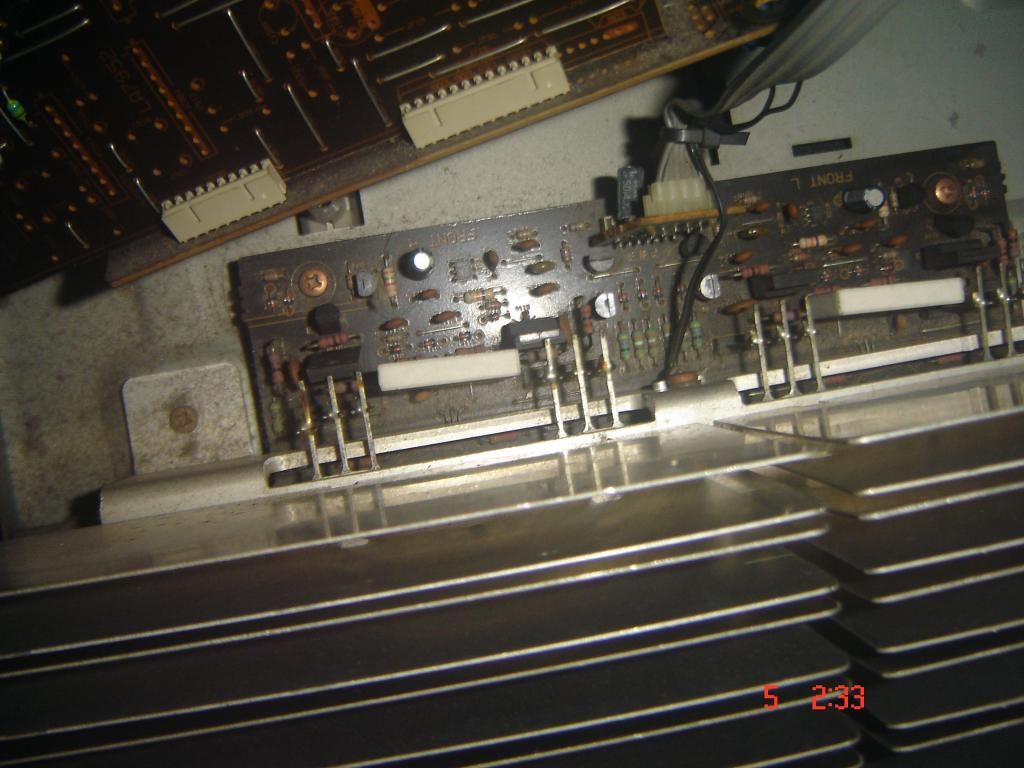
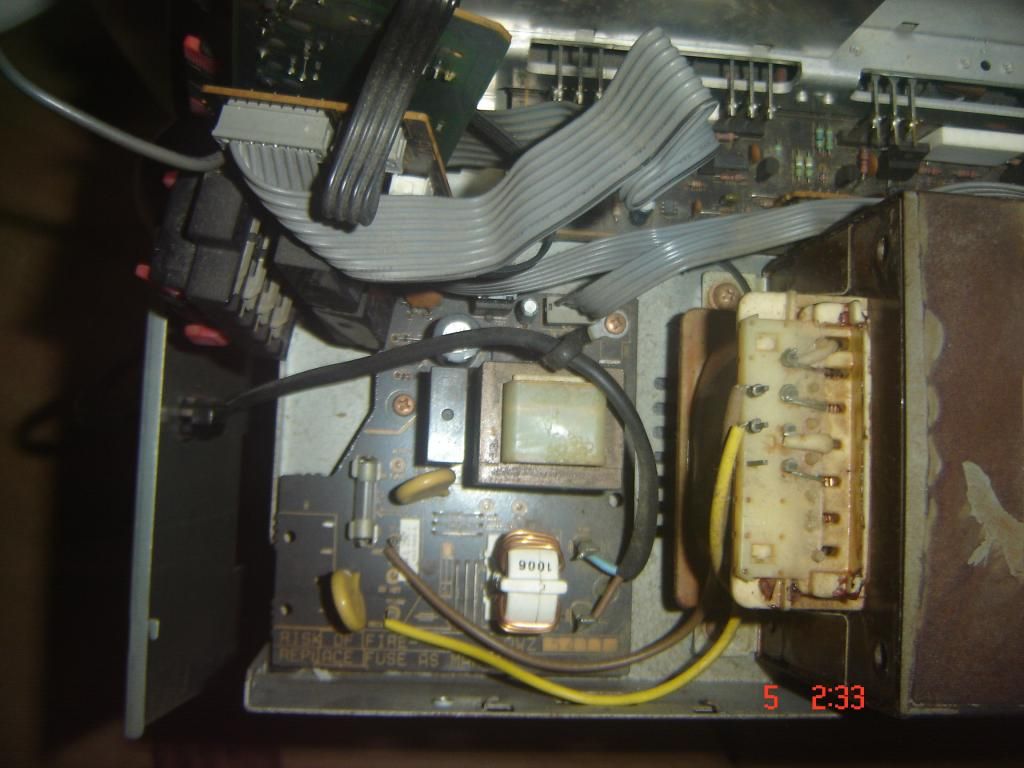

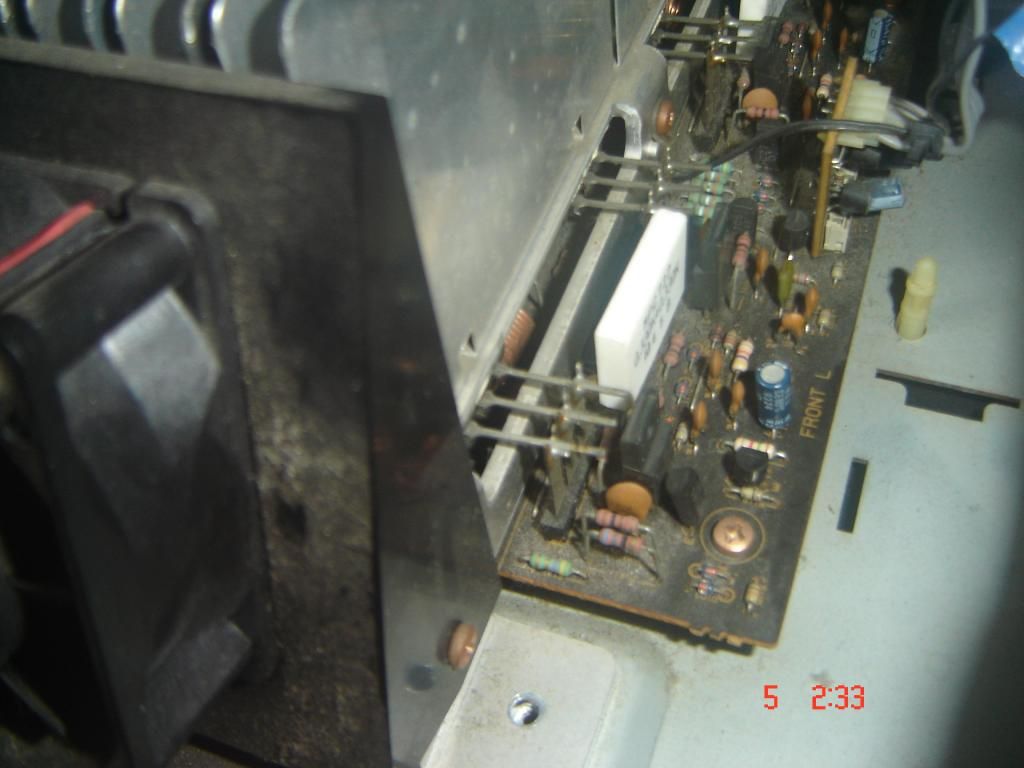
Stripped the AVR today. Basically looks like it has 4 identical power stages. But the Rear channel runs on a separate rail volatile?
Some pictures





I have a Teac pro logic that does the same thing. Check the schematic, but on mine, the entire amp schematic is the same on all four channels with the exception of the output transistors.
The rail voltage is stepped down by a relay when the amp is in surround mode so that all devices are limited to around 100 watts.
So check your output devices and/or schematic to see what's going on there. You might have to upgrade some parts on the rear and center channel boards. Do a recap, doesn't look like a whole lot of them but still.
If it all checks out, I would get a toroid from AnTek, build a nice capacitor bank, and wire the boards up with rca connectors for each one.
The rail voltage is stepped down by a relay when the amp is in surround mode so that all devices are limited to around 100 watts.
So check your output devices and/or schematic to see what's going on there. You might have to upgrade some parts on the rear and center channel boards. Do a recap, doesn't look like a whole lot of them but still.
If it all checks out, I would get a toroid from AnTek, build a nice capacitor bank, and wire the boards up with rca connectors for each one.
Looks golden on the center, left ,and right amps, but the rear is different and doesn't look very upgradable so you might be stuck at 50 watts for that one. However, check the data sheets on those transistors, I'm guessing you can or can make it so it's ok on the same voltage as the other three amps. Oh and make sure that fan can still run! Good luck!
On J21, the DC protection and overload protection go off-board, so you'll have to deal with those and adding relays on the 4 outputs. I would keep the headphone connections on J26. And on c17 and 18 be sure to connect the grounds when running to rca's. Add a 4.7uF 50V cap (I like Nichicon FG personally) in front of the L and R channels for DC protection.
- Status
- Not open for further replies.
- Home
- Amplifiers
- Solid State
- Salvaging the Power Amp sections of 90s Prologic
